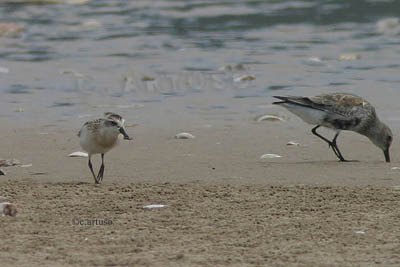My trip to South Korea was to visit my wife’s family and not primarily for birding but before I met up with Nial I had the chance to visit a few sites around Busan including the headland of Tae Jong Dae, where I was treated to a lifer in the form of a flock of Streaked Shearwaters.

But on the 26th the excitement as we headed out into the estuary in the boat Nial had organized. We quickly found several of the globally vulnerable Chinese Egret, a species I had not seen since I was in Singapore 7 years previously.

The shorebirds were dispersed fairly widely on the various islands and sandbars. The diversity of plovers was impressive including the very familiar Black-bellied Plover or Grey Plover (I wish we could change the name of this beautiful species to Silver Plover)

The impressive Greater Sand Plover with their long legs and plump shape and stout features were a real treat.

The Lesser Sand Plover, formerly known as Mongolian Plover (and who knows maybe one day the coastal and interior forms will be split back to Lesser Sand versus Mongolian Plovers) was also present and, unlike the Greater Sands, some showed a touch of lingering breeding colour.

And alongside the sand plovers were the smaller Kentish or Snowy Plovers.

Here is a comparison shot of the two sand plover species – note the bulkier proportions of the Greater Sand, longer legs and heavier bill.

And here a Greater Sand Plover dwarfs three Kentish Plovers.

Eurasian Oystercatchers were also present and looking fine in their striking black, white and red attire.

Among the many sandpiper species were some I was very familiar with like Sanderling

And Whimbrel (here a juvenile takes flight)

And others that I had only seen once or twice before like this beautiful Far Eastern Curlew with their huge bill. Interestingly to me their seemed to be roughly equal numbers of Eurasian and Far Eastern Curlew, whereas in my previous birding in South East Asia, Far Eastern Curlew was a rarity (presumably because their flight path takes them away form the Asian continent at a fairly northern latitude and out over the Pacific towards Australia)

Red-necked Stint is a bit like the North American equivalent of Semipalmated Sandpiper (difficult to tell apart in this plumage too) as was present in the estuary in the thousands.

Long-toed Stint is a bit like our Least Sandpiper (similarly coloured although somewhat differently proportioned), although unlike Least Sandpiper I have always found Long-toes very difficult to encounter. I was delighted to photograph this bird.

There is no mistaking the unique Terek Sandpiper!

And the classy Broad-billed Sandpiper, which has always been one of my favourites.

But the absolute highlight of the day (and the lifer had been hoping for) was the amazing and unique Spoon-billed Sandpiper (seen here alongside a Dunlin)… what a snoz! The Spoon-billed Sandpiper is critically endangered and their numbers appear to be plummeting. This is one species in desperate need of immediate conservation action and protecting the stop-over sites they rely on in South Korea is an important part of that action.


Great serie! I love your blog, i will keep reading ;)
ReplyDelete